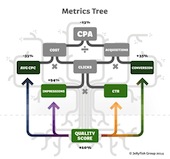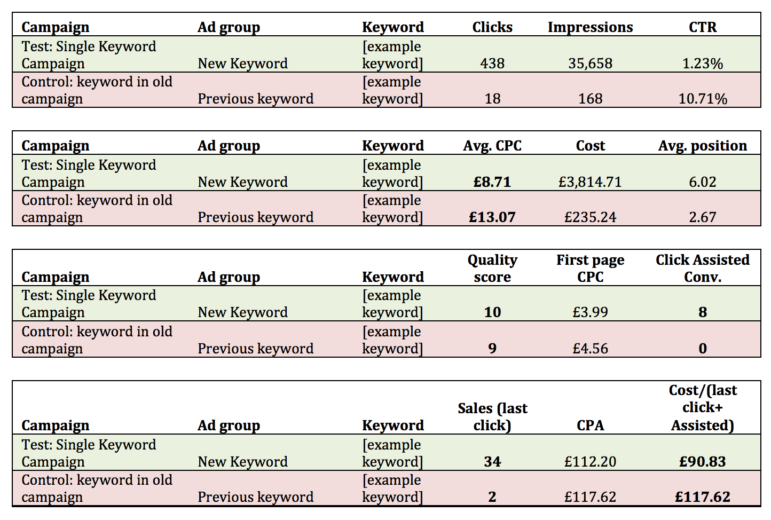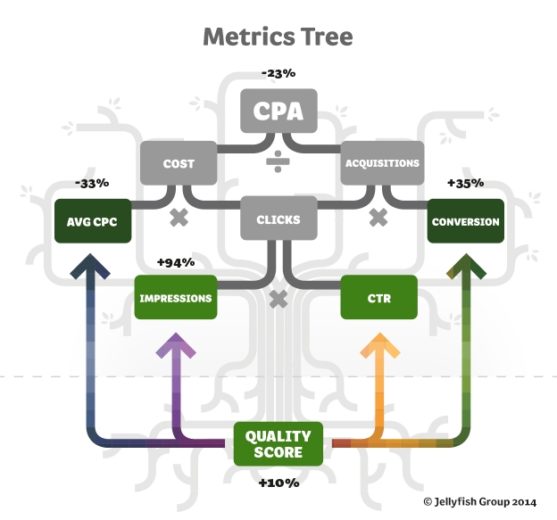Today’s post comes from Chris Swan. Chris is a fully qualified PPC manager for Jellyfish with five years experience specializing in PPC. He began working globally for brand awareness clients, picking up on the importance of site engagement metrics as performance indicators – rather than sales. And as his role evolved he later worked with direct response clients with the all important ROI/CPA. You can get in touch with Chris on his LinkedIn or Google+.
—
Here’s a common challenge for PPC marketers:
Keywords that generate a significant proportion of sales for any account may not be triggering ads as often as they should be, and keyword quality score may have potential to improve, no matter how relevant the ad copy and landing page are.
A structure test was carried out across different accounts and verticals (industries) this year. On each occasion – the ad copy and landing page were kept the same, but quality score was consistently improved.
This resulted in the conclusion that a single structure change can increase quality score, even if the ad copy and landing page were kept the same. The improved quality score can help to reduce the average cost per click, cost overall, and the all-important cost per sale. An improved quality score (from a restructure) can allow an ad to rank higher up the page for the same average CPC as before (based on the Ad Rank Formula), and therefore increase CTR indirectly as well.
Reason for the test
As we know, more granular campaigns promote a more efficient allocation of budget. However expensive keywords (or even match types) can still divert investment away from top performing keywords.
Google defines Impression share (IS) as “the number of impressions you’ve received divided by the estimated number of impressions you were eligible to receive. Eligibility is based on your current ads’ targeting settings, approval statuses, bids, and Quality Scores.” An 80% impression share means that your ad has opportunity to show 20% more often.
If a keyword is known to generate and assist in a significant proportion of the total sales in any account, but is currently operating below 80% impression share within the current campaign, this keyword should in theory be structured out into its own campaign. The purpose of this test was to therefore isolate and ‘free up’ a top performing (but currently suppressed) keyword – by structuring the keyword out into a dedicated campaign.
This top performing keyword could in theory trigger more ads and convert more often if it was in a dedicated campaign – where an entire campaign budget can be utilised. Also, if a keyword has a very significant or even singular impact on overall account performance, it can be better monitored, analysed and optimised in its own campaign. With more data to feed into the Google algorithm, the top converting keyword should increase in quality score by giving Google more confidence in the potential of the keyword.
Test objectives
To measure the uplift in sales volume (last click + assisted), CPA and quality score of the example keyword, if the keyword was unleashed into its own campaign to spend to its true potential.
Specific Test Metrics
- Changes in quality score
- Average cost per click
- Average position
- Sales volume
- Changes in CPA
- Changes in weighted CPA (Cost divided by last click and assisted Sales combined).
Test Criteria
- Date range: Control: Jan 1st to April 26th, Test: 26th May to the 10th of April.
- [example keyword] keyword on exact
- Splitting out the [example keyword] into its own campaign (set up on legacy settings)
- The Same Adcopy was used – carried over (history did not come with it, contrary to Google theory)
- The Same Landing page was used
- Neither campaign included close variants (campaign setting).
- No negatives used in new campaign – example keyword on exact as a negative across the rest of the account.
Results
Initially there was a settling in period – subsequently the main result was that quality score improved, with the new single keyword campaign including the same adcopy and landing page as was the case in the previous campaign.
Date range:
- Control: Jan 1st to April 26th.
- Test: April 26th to May 10th.
Analysis
Google defines Quality score as “A measurement of how relevant your ads, keywords, and landing page are to a person seeing your ad”.
Quality score for the keyword increased from 9 to 10 when restructured into a dedicated campaign – which is significant – a 10% improvement.
A 10% improvement in quality score helped shave 13% off the first page bid CPC requirement (from £4.56 to £3.99)
And helped reduce the average CPC by 33% (from £13.07 down to £8.71)
The new desktop only (restructured) keyword generated more sales and assisted more sales in just 16 days – compared to what the same keyword in the old structure generated over 3 months – even when combining sales across all devices.
As well as generating more last click sales, and assisting more sales, the new structure for the [example keyword] keyword has helped improve CPA – reducing it by 5%, and decreased weighted CPA by 23% (=cost / (sales + assisted sales).
Other Examples of Structure success:
On a second example account in an insurance vertical, (on the 5th of August 2013) – the new structure resulted in quality score increasing from 8 to 10 after the settling in period.Quality score increased on the same keyword, despite appearing against the same ad, with the same landing page.
More recently in a telecoms and technology vertical – this time a broad match keyword was structured out into a dedicated campaign – resulting in a quality score increase of 2, from 7 to 9 so far. Again, quality score increased on the same keyword, despite appearing against the same ad, with the same landing page.
Conclusion:
The keyword structure test resulted in an improvement in the quality score of that keyword, when structured out of the current campaign and placed into a separate, dedicated campaign. Improvements in Quality score will (all other things remaining equal) have a knock on affect to reduce the average cost per click (Avg CPC), and cost per sale, for any account – as seen in the Jellyfish Metrics Tree below. It’s therefore clear from this test that adopting a more granular structure can positively impact quality score, with resulting reductions in cost of clicks, overall cost, and the all important cost per sale.
If you have any comments or questions on this case study, feel free to ask away in the comments section below!








